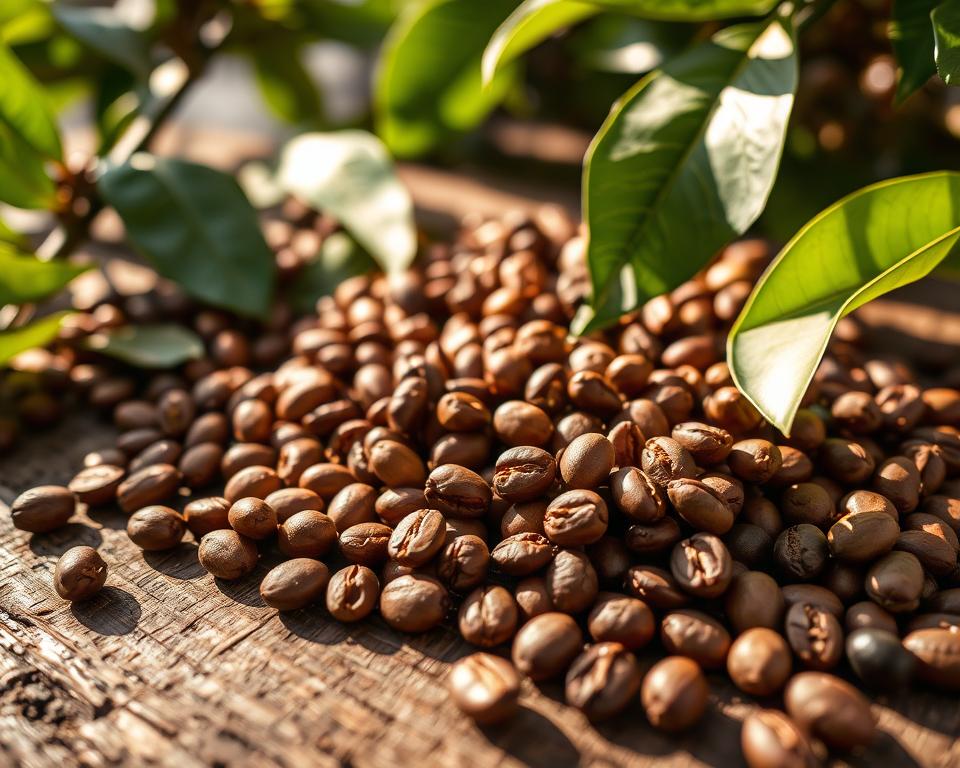Single origin coffee is a unique type, grown in a specific region, known for its distinct flavor. Each cup reflects the unique taste of its origin, much like single origin coffee from local beans. This focus on distinct flavors has made single origin coffee increasingly popular among coffee lovers.
Unlike blends, single origin coffee comes from one region or country. This method ensures a consistent taste in every batch, offering a fresher product than mass-produced blends. Thus, it’s a favorite among those who value the subtleties of specialty coffee and local beans.
Key Takeaways
- Single origin coffee is grown in a specific region, resulting in a unique flavor profile.
- Each cup of single origin coffee carries the signature flavors and characteristics of a particular geographic location.
- Single origin coffee is a staple in the specialty coffee industry, with a growing popularity among coffee enthusiasts.
- Local coffee beans and single origin coffee are often used interchangeably, emphasizing the importance of distinct flavors and characteristics.
- Single origin coffee demands special attention to roasting profiles, affecting strength, acidity, and body.
- Recognizing and understanding the single-origin label enhances consumer appreciation of coffee variety and origin.
- Specialty coffee shops offer a distinct, handcrafted experience not found in commercial coffee brands, often featuring single origin coffee and local coffee beans.
What is Single Origin Coffee?
Single-origin coffee is coffee grown in a single known geographic area. It offers a unique flavor profile that mirrors the region’s characteristics. This coffee is often linked with small batch roasting. This method allows for precise control over the roasting, enhancing the distinct flavor. The origin is key, as it greatly influences the coffee’s flavor and quality.
Coffee aficionados value single-origin coffee for its distinct taste, which varies by region. For example, coffee from Mexico’s Soconusco region boasts a unique flavor. This is due to the region’s volcanic soil.
Definition and Characteristics
Single-origin coffee is often sourced through direct trade coffee practices. This method allows farmers to sell their beans directly to roasters, cutting out intermediaries. It ensures a fair price for the farmers and promotes sustainable coffee sourcing. It encourages farmers to adopt eco-friendly practices, improving coffee quality.
Importance of Origin
The origin of coffee is vital in shaping its flavor. Single-origin coffee offers a chance to experience the unique traits of a specific region. Whether it’s the bright, fruity notes of Ethiopian coffee or the rich, chocolatey flavors of Brazilian coffee, it truly reflects the region’s essence.
How Single Origin Coffee is Sourced
Single origin coffee comes from specific regions, each with its own unique terroir. This terroir greatly influences the coffee’s flavor. Organic coffee beans from different places can taste distinctly different.
Artisanal coffee roasters are crucial in finding and roasting these high-quality beans. They build strong relationships with farmers. This ensures the coffee is grown sustainably, leading to a superior product.
- Region: Coffee from different regions can have distinct flavor profiles.
- Farm: The specific farm where the coffee is grown can impact the flavor.
- Processing method: The method used to process the coffee can affect the flavor and quality.
Understanding these factors and collaborating with artisanal coffee roasters allows coffee enthusiasts to enjoy a unique and premium single origin coffee experience.
| Region | Flavor Profile |
|---|---|
| Ethiopia | Fruity and floral |
| Colombia | Rich and balanced |
Popular Single Origin Coffee Regions
Single origin coffee is celebrated for its distinct flavors, shaped by the region, farm, or variety. The origin significantly influences the coffee’s taste. Ethiopia, for instance, is famous for its bright acidity and complex, fruity notes, appealing to many coffee lovers.
Other notable regions include Colombia, Guatemala, Brazil, and Kenya. Each offers unique flavors, from Colombia’s balanced smoothness to Guatemala’s rich diversity. Whether you enjoy Ethiopian’s fruity and floral notes or Kenyan’s intense flavors, there’s a single origin coffee for you.
Exploring single origin coffee requires understanding factors like climate, soil, and processing methods. Knowing these can help you choose a coffee that matches your taste. With the rise of specialty coffee, now is an exciting time to explore the vast world of single origin coffee.
| Region | Flavor Profile |
|---|---|
| Ethiopia | Bright acidity, complex, fruity flavors |
| Colombia | Balanced and smooth flavors |
| Guatemala | Rich and diverse tastes, notes of chocolate and caramel |
| Brazil | Rich and heavy body |
| Kenya | Intense, fruity flavors |
Brewing Methods for Single Origin Coffee
The brewing method significantly influences the taste and quality of single origin coffee. Utilizing local coffee beans and small batch roasting can highlight the coffee’s unique flavors. Various brewing techniques, such as pour-over, French press, and espresso, can accentuate these distinct tastes.
Some popular brewing methods for single origin coffee include:
- Pour-over: allows for a high degree of control over brewing parameters, resulting in a clean and nuanced flavor
- French press: produces a rich and full-bodied flavor, with a heavier body and more sediment than pour-over
- Espresso: creates a concentrated and intense flavor, with a thick crema and a strong aroma
Choosing the right grind size and brewing technique is essential to unlock the unique flavors of single origin coffee. For instance, pour-over demands a finer grind, whereas French press employs a coarse grind. Espresso necessitates an extremely fine grind, and its brewing time is notably shorter than other methods.

Exploring different brewing methods and techniques can lead to discovering the ideal way to enjoy single origin coffee. Whether you seek a bright and acidic taste or a rich and smooth one, there’s a brewing method that can highlight the unique qualities of your local coffee beans and small batch roasting.
| Brewing Method | Grind Size | Brewing Time |
|---|---|---|
| Pour-over | Finer grind | 3-4 minutes |
| French press | Coarse grind | 4-5 minutes |
| Espresso | Very fine grind | 20-30 seconds |
Tasting Single Origin Coffee
Tasting single origin coffee offers a unique and nuanced experience. The flavor of coffee is heavily influenced by its growing environment, known as “terroir.” This leads to distinct flavor profiles in single origin coffees, depending on their region of origin. Sustainable coffee sourcing and direct trade coffee practices also play a role in the coffee’s flavor and quality.
To truly appreciate single origin coffee, conducting a coffee cupping is essential. This involves assessing the coffee’s aroma, flavor, and mouthfeel. Common flavor notes include fruity, floral, and chocolatey. Identifying these notes helps coffee enthusiasts understand the coffee’s origin and characteristics.
Pairing single origin coffee with food can also enhance the experience. Popular pairings include coffee with sweet treats like pastries or chocolate, or with savory dishes like breakfast items or snacks. Exploring different pairings allows coffee lovers to find the perfect match for their taste preferences.
The Benefits of Choosing Single Origin Coffee
Opting for single-origin coffee comes with several advantages, including backing local farmers and fostering sustainability. Buying single-origin coffee directly aids farmers in their efforts to cultivate premium organic coffee beans. This choice also nudges artisanal coffee roasters towards acquiring beans from nearby farms. This move enhances the transparency and fairness of the supply chain.
Single-origin coffee stands out due to its distinct flavor profile. The beans, coming from a single farm or area, showcase more nuanced and complex flavors. This is because each region’s unique climate, soil, and processing methods contribute to its distinct taste.
Supporting Local Farmers
Choosing single-origin coffee means supporting local farmers who are committed to quality. This choice advocates for fair trade, ensuring farmers get a just price for their beans. In turn, you savor a cup of coffee that’s not only unique but also rich in taste and aroma.
Sustainability Considerations
Single-origin coffee is a greener choice compared to blended coffee. It has a lower carbon footprint and less environmental impact. Many artisanal coffee roasters also embrace eco-friendly practices. They use sustainable packaging and strive to minimize waste.
How to Choose the Right Single Origin Coffee
Choosing the right single origin coffee involves several key factors. Labeling and certifications offer insights into the coffee’s origin, flavor, and quality. It’s also important to understand roast levels, as they significantly impact the coffee’s taste and quality.
Begin by visiting a specialty coffee shop. These places offer a variety of single origin coffees from across the globe. Online retailers, like those on coffee blogs, also provide a broad selection of single origin coffees.
Here are some tips for selecting the right single origin coffee:
- Begin with a light roast to fully appreciate the coffee’s flavor
- Try different brewing methods to discover your preferred way of enjoying it
- Focus on the coffee’s flavor notes and acidity
By considering these factors and tips, you can find the perfect single origin coffee for your taste. Whether you’re an experienced coffee lover or new to single origin coffee, there’s a wide variety to explore. Each coffee offers a unique experience, catering to every palate.
| Coffee Origin | Flavor Profile | Price |
|---|---|---|
| Finca El Puente, Honduras | Chocolate, caramel | $35 (2 x 12 oz bags) |
| La Golondrina, Colombia | Fruity, floral | $44 (single-origin subscription) |
Common Misconceptions about Single Origin Coffee
Many believe single origin coffee is always pricier than blends. Yet, its unique taste and authenticity justify the cost. Quality and flavor are key, not just price. Local beans and small batch roasting enhance these aspects.
Some think single origin coffee is always pricier than blends. While true, its distinct taste and quality make it worth the extra cost. Quality and flavor are crucial, not just price. Local beans and small batch roasting significantly impact flavor and quality.
Single Origin vs. Blends
Single origin coffee comes from one specific region. Blends, on the other hand, mix beans from various places. This blending aims for balanced flavor and acidity. Blends can include different roasts, like Dark Roast and Light Roast.
The Price Factor
The term “single origin” is not officially defined, causing confusion. Beans can come from a single country, region, farm, or even a small lot. These are often seen as premium due to their rarity. Blends, sourced from multiple places, might be cheaper because of their higher sourcing costs.

Quality Vs. Brand Name
Specialty roasters are known for quality and ethical sourcing. The rarity of single origin coffees appeals to some. They offer unique flavors from a single region. The term “location” can refer to a broader area, with beans from multiple farms.
| Coffee Type | Characteristics |
|---|---|
| Single Origin | Unique flavor profile, high quality, limited availability |
| Blends | Balanced flavor, acidity, multiple roasts available |
Where to Buy Single Origin Coffee
Coffee aficionados looking for the finest single-origin coffee have several avenues to explore. Specialty coffee shops are a top choice, as they directly source beans from farmers and roasters. This ensures quality and supports sustainable practices. Online retailers also provide a vast selection of single-origin coffee beans from around the world. This makes it simple to find new flavors. Local roasteries offer a unique experience, connecting you with the artisans behind the coffee.
Whether you prefer the personalized touch of a specialty coffee shop, the ease of online shopping, or the local vibe of a roastery, there’s something for everyone. By choosing sustainable, direct trade, and organic coffee, you enhance your coffee experience. You also support the farmers and roasters who work tirelessly to bring these exceptional beans to you.
FAQ
What is single-origin coffee?
What are the characteristics of single-origin coffee?
How is single-origin coffee sourced?
What are some popular single-origin coffee regions?
What are the best brewing methods for single-origin coffee?
How do you taste and appreciate single-origin coffee?
What are the benefits of choosing single-origin coffee?
How can I choose the right single-origin coffee?
What are some common misconceptions about single-origin coffee?
Where can I buy single-origin coffee?

Robert Lowe is a writer at WyNeeds, where he shares his expertise and passion for coffee. With a deep appreciation for the art of brewing, he explores various coffee techniques, bean origins, and industry innovations. His engaging and informative content helps coffee lovers of all levels discover new flavors, refine their brewing skills, and stay updated on the latest trends in the coffee world.

